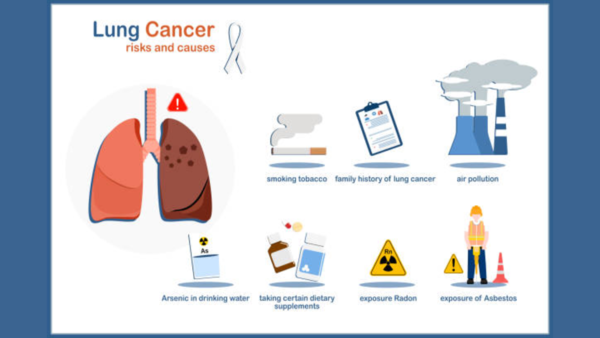On one hand while awareness is rising and people are being educated about the harmful effects of smoking, on the other hand, people who never smoked in their life are being diagnosed with
lung cancer
.
“Because there are currently no screening guidelines for nonsmokers, lung cancer can be difficult to detect in its early stages,” writes one reputed health journal.
10% to 20% of people who develop lung cancer have never smoked
A recent Indian study has found that lung cancer accounts for a substantial portion of cancer-related deaths in India. Researchers from Tata Memorial Hospital, have found that lung cancer research output from India to global research output stands at 0.51. The findings of the study published in Lancet’s eClinical Medicine Journal manifests in India ten years earlier as compared to Western countries, where the age of diagnosis is between 54 and 70. This stresses that India’s younger population is more vulnerable to lung cancer.
“The rate of lung cancer has surged from 6.62 per 1,00,000 in 1990 to 7.7 per 1,00,000 in 2019 and a significant rise is expected in urban areas by 2025,” the study found.
While the symptoms of lung cancer need to be discussed separately, let’s find out what’s driving lung cancer cases these days.
Air pollution is the culprit
Air pollution, particularly from sources such as vehicle emissions, industrial byproducts, and burning fossil fuels, has a substantial impact on lung health and can increase the risk of lung cancer.
“Air quality in the national capital has already reached the “Very Poor” category as of October 23 and the situation is expected to remain “very poor” in the next seven days as per the air quality early warning system for Delhi. As per the forecast of the Indian Meteorological Department, the ventilation index in Delhi on Diwali night is forecasted to be less than 1000 m2/s, with an average wind speed between 1 to 2 m/s during the evening/ night of 31st October. Typically, when the ventilation index is lower than 6000 m2/s with an average wind speed of less than 2.7 m/s, it is not favourable for the dispersion of pollutants. Hence, pollutants from firecrackers (in addition to other sources) will not be able to blow away and the concentration of particulate particulate matter would further rise sharply,” says Abhishek Kar, Senior Programme Lead, CEEW.
“Air pollution is a big challenge that we are facing. It has become a serious threat to our children, especially those who are reeling through respiratory ailments and allergies. The arrival of winter brings misery as pollution levels go alarmingly high. The presence of particulate matter PM 2.5 in air aggravates respiratory diseases. Children are vulnerable to such high levels of pollution in the air, which could potentially cause life-threatening conditions like lung cancer and asthma. A concerted effort by both the government and citizens is essential to mitigate air pollution. We must be collectively committed to addressing this pressing challenge on all fronts, engaging all stakeholders. Technological innovations, like RECD for diesel engines, Carbon capture, utilization, and storage (CCUS) technologies could be effective to checkmate air pollutants and particulate matters. This apart, the government must clamp down on strict measures to mitigate air pollution,” says Anmol Khandelwal, Executive Director, Chakr Innovation.
Prolonged exposure to fine particulate matter (PM2.5) and nitrogen dioxide in polluted air has been linked to lung inflammation and cellular mutations, conditions that can trigger cancerous growths. Studies have shown that people living in urban or heavily industrialized areas have a higher risk of developing lung cancer, even if they don’t smoke. As industrial activity increases worldwide, more individuals are exposed to these harmful pollutants, leading to an uptick in lung cancer rates.
Unfortunately secondhand smoke plays a key role
Secondhand smoke remains a significant risk factor for lung cancer in non-smokers, especially those who live or work with smokers. Exposure to smoke-filled environments over time can cause damage to the lungs, with risks comparable to those faced by smokers. While many countries have instituted smoke-free laws, non-smokers may still be exposed to passive smoke in public areas or at home, putting them at risk.
The role genes play
Genetics also play a role in lung cancer among non-smokers. Certain genetic mutations, which may be inherited, can predispose individuals to lung cancer, even if they have never smoked. For example, mutations in genes like EGFR (epidermal growth factor receptor) and ALK (anaplastic lymphoma kinase) are more commonly found in lung cancer patients who have never smoked. These mutations can trigger abnormal cell growth in the lungs, potentially leading to cancer. Genetic factors combined with environmental exposures increase the complexity of lung cancer risk for non-smokers.
What are the other dangers of smoking for non smokers?
Smoking poses significant risks to non-smokers. Regular exposure to secondhand smoke increases the risk of cardiovascular diseases, such as heart attacks and strokes. Even brief exposure can lead to the narrowing of blood vessels, increased blood clotting, and other conditions that harm the heart and blood circulation.
Key symptoms of lung cancer you must pay attention to
Respiratory issues are another major concern for non-smokers exposed to smoke. Secondhand smoke can cause immediate breathing problems, especially in children and people with asthma, as well as chronic respiratory conditions like bronchitis. It has been linked to a higher incidence of asthma attacks, increased respiratory infections, and a weakened immune system.
Secondhand smoke also affects pregnant women and young children. Pregnant women exposed to smoke risk complications such as low birth weight, preterm birth, and developmental issues in their babies. For children, passive smoking is associated with ear infections, developmental delays, and even sudden infant death syndrome (SIDS). Overall, secondhand smoke exposure is a severe public health issue that can lead to a range of diseases and health complications for non-smokers.
I’m Manas Ranjan Sahoo: Founder of “Webtirety Software”. I’m a Full-time Software Professional and an aspiring entrepreneur, dedicated to growing this platform as large as possible. I love to Write Blogs on Software, Mobile applications, Web Technology, eCommerce, SEO, and about My experience with Life.




